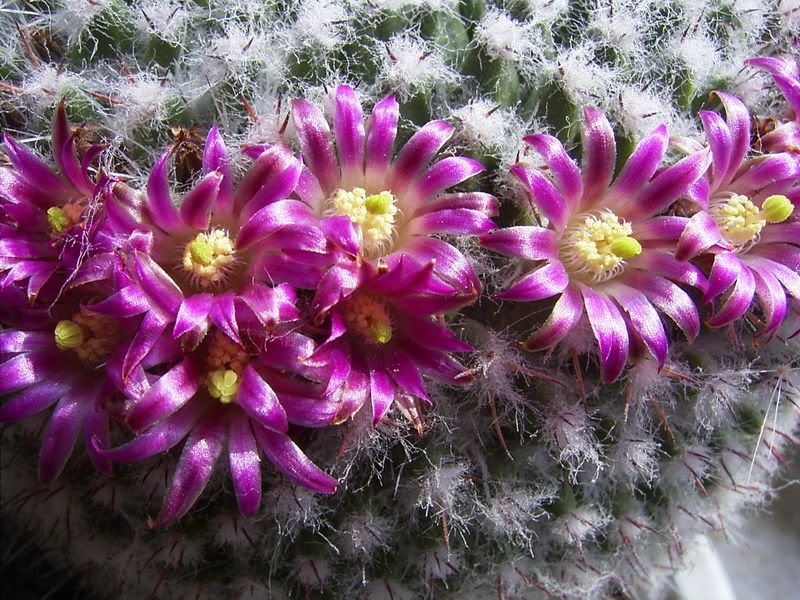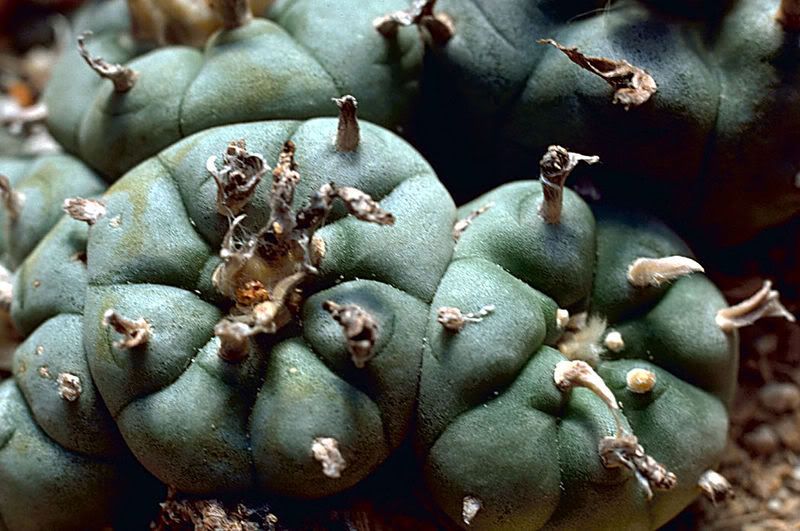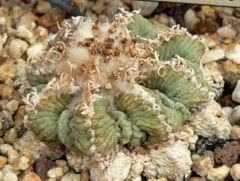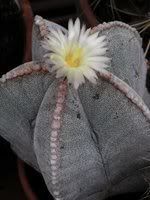The genus Mammillaria is one of the largest in the cactus family Cactaceae, with currently 171 known species and varieties recognized[citation needed]. The first was described by Carolus Linnaeus as Cactus mammillaris in 1753, deriving name from Latin mammilla = nipple, referring to the tubercules that are one of the plant's specific features. In 1812, the cactus specialist Adrian Haworth described the genus Mammillaria to contain this and related species.
 The distinctive feature of the genus is the specific development of an areole, that is split into two clearly separated parts, one occurring at the tubercule's apex, the other at its base. The apex part is spine bearing, and the base part is always spineless, but usually bearing some bristles or wool. The base part of the areole bears the flowers and fruits, and is a branching point. The apex part of the areole does not carry flowers, but in certain conditions can function as a branching point as well.
The distinctive feature of the genus is the specific development of an areole, that is split into two clearly separated parts, one occurring at the tubercule's apex, the other at its base. The apex part is spine bearing, and the base part is always spineless, but usually bearing some bristles or wool. The base part of the areole bears the flowers and fruits, and is a branching point. The apex part of the areole does not carry flowers, but in certain conditions can function as a branching point as well.The plants are usually small, globose to elongated, the stems from 1 cm to 20 cm in diameter and from 1 cm to 40 cm tall, clearly tuberculate, solitary to clumping forming mounds of up to 100 heads and posses radial symmetry. Tubercules can be conical, cylindrical, pyramidal or round. The roots are fibrous, fleshy or tuberous. The flowers are funnel-shaped and range from 7 mm to 40 mm and more in length and in diameter, from white and greenish to yellow, pink and red in color, often with a darker mid-stripe. The fruit is berry-like, club-shaped or elongated, usually red but sometimes white, yellow or green. Some species have the fruit embedded into the plant body. The seeds are black or brown, from 1 to 3 mm in size.
Mammillarias have extremely variable spination from species to species, and attractive flowers, making them specifically attractive for cactus hobbyists. Mammillaria plants are considered easy in cultivation, though some species are among the hardest cacti to grow.
Most of the mammillarias are native to Mexico, but some come from the southwest USA, the Caribbean, Colombia, Venezuela, Guatemala and Honduras.
Classification
The large and diverse genus Mammillaria has seen multiple attempts to subdivide the species in it into smaller groups within the genus or attempts to split it to multiple genera for better understanding of the plants relationship. Early classifications were performed by Pfeiffer (1837), Salm-Dick (1845) and Engelmann (1856). The genus Mammillaria included members of some modern genera like Coryphanta and Ariocarpus at that time. Classifications by Schumann (1898), Britton and Rose (1923), Berger (1929), Buxbaum (1951-56) and Moran (1953) followed, splitting the genus in parts and combining it back together again.
Later classification was performed by the cactus specialists Hunt, Reppenhagen and Luthy[citation needed], with a lot of work focusing on searching the meanings and value of the original plant descriptions, synchronizing them with modern taxonomic requirements and studying the morphology of plants and seeds, as well as ecological aspects of the genus. These works helped to expand the understanding of Mammillaria taxa.
Currently the classification of Mammillaria is in a state where few newly discovered species are likely, though some new species may yet be found when the chaos of names created earlier by commercial plant collectors is sorted out. Many names that were introduced for plants barely differentiated by a shade of flower color or variation in spination were eliminated in attempt to make the use of names consistent with the rest of the botanical world. The number of taxa, at one time way over 500, is now is below 200. Some genera (Dolichothele, Mammillopsis, Krainzia and others) have been merged back into Mammillaria, and others like Coryphantha and Escobaria were confirmed as separate.
Intense DNA studies of the genus are being conducted, with preliminary results published for over a hundred taxa, and this promising approach might soon end the arguments. Based on DNA results, the genus does not seem to be monophylic and is likely to be split into two large genera, one of them possibly including certain species of other closely related genera like Coryphantha, Ortegocactus and Neolloydia.
References
The species list is reproduced from cactiguide.com, which is sourced in turn from several books which are listed on that site. The principal book listed there is The Cactus Family by Edward F. Anderson.





